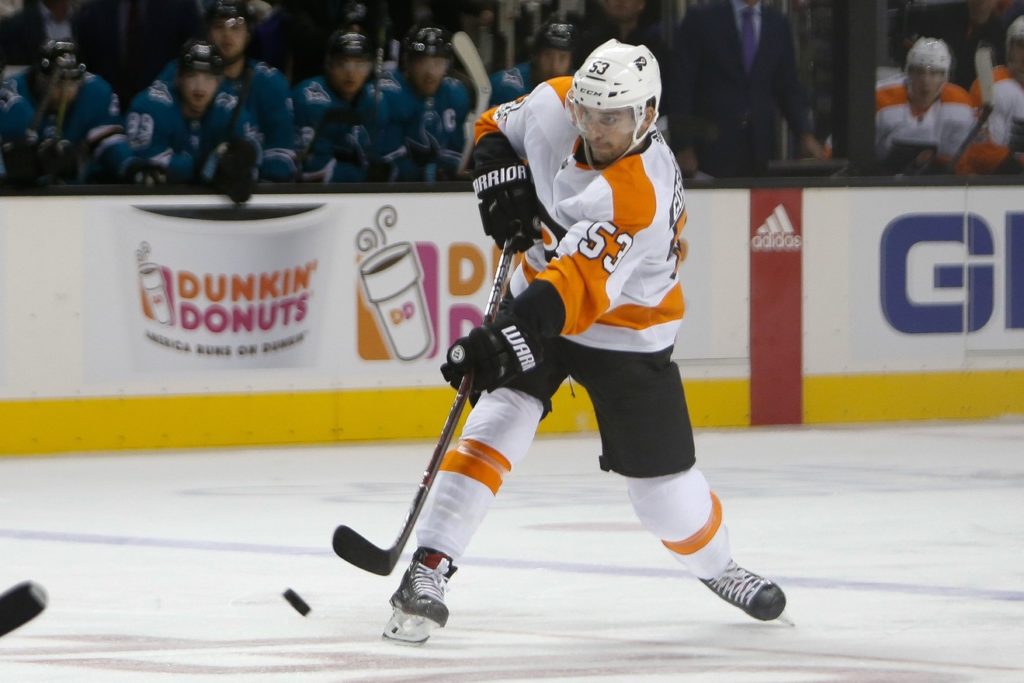Ad Disclosure
The Flyers Have Recharged Their Power Play
By Tim Reilly
Published:

Like any Flyers fan worthy of the title, I had been eagerly awaiting the Orange and Black’s return to the ice for the commencement of the 2017-18 campaign. Last season had ended with another premature, non-playoff exit; meanwhile, the hated Pittsburgh Penguins once again hoisted Lord Stanley’s Cup.
However, there was hope on the horizon. Finally, it seemed the seeds of the Flyers’ gradual rebuild would begin to break through the soil and bear fruit.
The blue chip blue line prospects that had been developing in the minors- Travis Sanheim, Robert Hagg, and Samuel Morin- have at last gotten a legitimate opportunity to make the NHL roster. Young defensemen Shayne Gostisbehere and Ivan Provorov have already entrenched themselves in the lineup. Meanwhile, Coach Dave Hakstol made room on his depth chart for forwards Jordan Weal and Taylor Leier, finally demonstrating a willingness to trade experience for speed.
If nothing else, this season would be different.
But I just wasn’t sure I would have the energy to stay awake for the 10:50 PM puck drop in San Jose. I’ve been working long hours, and I would have another early start on Thursday morning.
I needed a pep talk, so I called on an old friend to motivate me:

Needless to say, I made it through the entire game.
I was most interested to see how the Flyers’ power play operation would look. In the offseason, GM Ron Hextall had fired longtime assistant Joe Mullen, a power play specialist who directed the unit with great success until the latter part of last season. The Flyers hired Kris Knoblauch to replace him.
I will freely admit that I know nothing about Kris Knoblauch. What I do know is that the team’s attack on the man advantage had grown stagnant.
When the top power play line was set up last year, Claude Giroux would take his familiar place along the boards. The power play would typically run through him. Ghost would camp out along the blue line, looking for openings to shoot the puck. Jakub Voracek occupied the other side of the ice, while Brayden Schenn and Wayne Simmonds would camp out around the crease.
For a long time, the unit was incredibly productive. In fact, their output routinely carried the Flyers’ offense. But somewhere along the way, the passing became too predictable. Giroux would study the defense and slide the puck to Gostisbehere, who would then take a shot, return the puck to Giroux, or pass to Voracek. Cross ice passes between Voracek and Giroux evaporated for some reason. Giroux’s one-timer seemed to miss the net with greater frequency, while Gostisbehere’s recovery from a hip injury limited his effectiveness.
Teams began keying on Giroux, knocking him off the puck or forcing him to make a pass before he could create a scoring chance. The puck would routinely find its way behind the net, where Schenn, Simmonds, and Voracek would have to waste precious seconds prying it away from penalty killers.
In short, the power play was not very dynamic by the end of last season. After boasting a league-leading twenty-five percent scoring rate in December, the Flyers’ special teams dipped to 14th in the league by the conclusion of regular season play. The organization needed to make a change, and often in hockey a new voice is all that is needed to jump-start a talented core.
On opening night, the Flyers’ special teams proved pivotal in a 5-3 victory over the Sharks. The team scored on 3 of its 5 power play chances, and, though the goals came fast, there were some noticeable differences in the offensive approach.
For one, the second unit was given ample time to establish itself. The tactic worked, as the line scored on its first chance of the night. Check out this goal off the stick of Jordan Weal:
Its Weally good!
Jordan Weal scores on the PP to extend the Flyers lead to 2. pic.twitter.com/T4SflCRKaF
— Broad Street Hockey (@BroadStHockey) October 5, 2017
On the play, Ghost started the rush by passing to Weal. Weal then passed the puck to Konecny along the boards and took a line toward the faceoff dot. Konecny fed him the puck, and Weal deposited it in the back of the net. It was a quick strike, just like the second and third power play goals of the night.
Those goals were generated from shots off of faceoff wins at the beginning of the man advantage. Both also came courtesy of Wayne Simmonds, who deflected offerings from Gostisbehere and Voracek, respectively.
There was much less deliberation. Passes were quicker, which put pressure on the Sharks’ penalty killers. Even when the Flyers didn’t score, they were generating chances. Giroux and company did not tether themselves to their preferred spots; instead, there was much more motion of skaters, which resulted in a more aggressive movement of the puck.
All in all, it was a solid start to the season. We’re going to learn a lot about this Flyers team very quickly. The Orange and Black are in the midst of a four-game road trip that will culminate with a match-up against the Nashville Predators, the defending Western Conference champs. Nine of their first eleven games are against teams that made the playoffs last year.
It’s an unforgiving slate, but one that will be more manageable if the power play can return to prominence.
Tim Reilly is a freelance writer from Northeast Philadelphia. He can be reached at reillyt7@gmail.com.